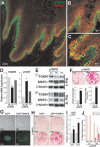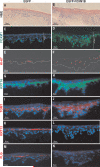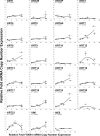Induction of human epithelial stem/progenitor expansion by FOXM1
- PMID: 21062979
- PMCID: PMC3044465
- DOI: 10.1158/0008-5472.CAN-10-2173
Induction of human epithelial stem/progenitor expansion by FOXM1
Erratum in
- Cancer Res. 2011 Jan 1;71(1):290
Abstract
Stem cells are permanent residents of tissues and thought to be targets of cancer initiation. The frequent, and often early, upregulation of the FOXM1 transcription factor in the majority of human cancers suggests that it may participate in the initiation of human tumorigenesis. However, this hypothesis has not been tested. Herein, we show that targeting the ectopic expression of FOXM1 to the highly clonogenic cells of primary human keratinocytes with stem/progenitor cell properties, but not to differentiating cells, caused clonal expansion in vitro. We show, using a functional three-dimensional organotypic epithelial tissue regeneration system, that ectopic FOXM1 expression perturbed epithelial differentiation generating a hyperproliferative phenotype reminiscent of that seen in human epithelial hyperplasia. Furthermore, transcriptional expression analysis of a panel of 28 epithelial differentiation-specific genes reveals a role for FOXM1 in the suppression of epithelial differentiation. This study provides the first evidence that FOXM1 participates in an early oncogenic pathway that predisposes cells to tumorigenesis by expanding the stem/progenitor compartment and deregulating subsequent keratinocyte terminal differentiation. This finding reveals an important window of susceptibility to oncogenic signals in epithelial stem/progenitor cells prior to differentiation, and may provide a significant benefit to the design of cancer therapeutic interventions that target oncogenesis at its earliest incipient stage.
Copyright © 2010 AACR.
Figures





Similar articles
-
Two mechanisms regulate keratin K15 expression in keratinocytes: role of PKC/AP-1 and FOXM1 mediated signalling.PLoS One. 2012;7(6):e38599. doi: 10.1371/journal.pone.0038599. Epub 2012 Jun 27. PLoS One. 2012. PMID: 22761689 Free PMC article.
-
Aberrant activation of ERK/FOXM1 signaling cascade triggers the cell migration/invasion in ovarian cancer cells.PLoS One. 2011;6(8):e23790. doi: 10.1371/journal.pone.0023790. Epub 2011 Aug 17. PLoS One. 2011. PMID: 21858223 Free PMC article.
-
FOXM1 induces a global methylation signature that mimics the cancer epigenome in head and neck squamous cell carcinoma.PLoS One. 2012;7(3):e34329. doi: 10.1371/journal.pone.0034329. Epub 2012 Mar 26. PLoS One. 2012. PMID: 22461910 Free PMC article.
-
FOXM1 (Forkhead box M1) in tumorigenesis: overexpression in human cancer, implication in tumorigenesis, oncogenic functions, tumor-suppressive properties, and target of anticancer therapy.Adv Cancer Res. 2013;119:191-419. doi: 10.1016/B978-0-12-407190-2.00016-2. Adv Cancer Res. 2013. PMID: 23870513 Review.
-
FOX(M1) news--it is cancer.Mol Cancer Ther. 2013 Mar;12(3):245-54. doi: 10.1158/1535-7163.MCT-12-0712. Epub 2013 Feb 26. Mol Cancer Ther. 2013. PMID: 23443798 Free PMC article. Review.
Cited by
-
Role of the forkhead transcription factor FOXO-FOXM1 axis in cancer and drug resistance.Front Med. 2012 Dec;6(4):376-80. doi: 10.1007/s11684-012-0228-0. Epub 2012 Nov 3. Front Med. 2012. PMID: 23124885 Review.
-
Essential roles of FoxM1 in Ras-induced liver cancer progression and in cancer cells with stem cell features.J Hepatol. 2015 Aug;63(2):429-36. doi: 10.1016/j.jhep.2015.03.023. Epub 2015 Mar 28. J Hepatol. 2015. PMID: 25828473 Free PMC article.
-
Sumo-regulatory SENP2 controls the homeostatic squamous mitosis-differentiation checkpoint.Cell Death Dis. 2024 Aug 16;15(8):596. doi: 10.1038/s41419-024-06969-z. Cell Death Dis. 2024. PMID: 39152119 Free PMC article.
-
Self-renewal and differentiation of muscle satellite cells are regulated by the Fas-associated death domain.J Biol Chem. 2014 Feb 21;289(8):5040-50. doi: 10.1074/jbc.M113.533448. Epub 2013 Dec 27. J Biol Chem. 2014. PMID: 24375410 Free PMC article.
-
Independent evaluation of a FOXM1-based quantitative malignancy diagnostic system (qMIDS) on head and neck squamous cell carcinomas.Oncotarget. 2016 Aug 23;7(34):54555-54563. doi: 10.18632/oncotarget.10512. Oncotarget. 2016. PMID: 27409343 Free PMC article.
References
-
- Myatt SS, Lam EW. The emerging roles of forkhead box (Fox) proteins in cancer. Nat Rev Cancer. 2007;7(11):847–59. - PubMed
-
- Wierstra I, Alves J. FOXM1, a typical proliferation-associated transcription factor. Biol Chem. 2007;388(12):1257–74. - PubMed
-
- Laoukili J, Kooistra MR, Bras A, et al. FoxM1 is required for execution of the mitotic programme and chromosome stability. Nat Cell Biol. 2005;7(2):126–36. - PubMed
-
- Teh MT, Wong ST, Neill GW, Ghali LR, Philpott MP, Quinn AG. FOXM1 is a downstream target of Gli1 in basal cell carcinomas. Cancer Res. 2002;62(16):4773–80. - PubMed
Publication types
MeSH terms
Substances
Grants and funding
LinkOut - more resources
Full Text Sources
Other Literature Sources
Medical
Miscellaneous

